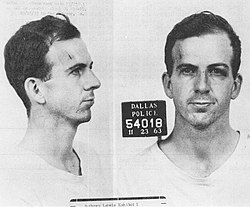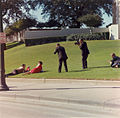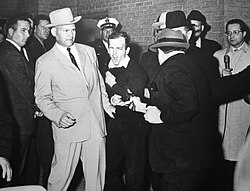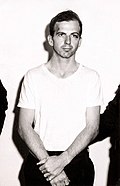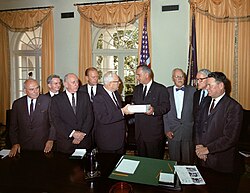Assassination of John F. Kennedy
John F. Kennedy, the 35th president of the United States, was shot and killed in Dallas, Texas on November 22, 1963. This happened while he was riding in the presidential motorcade through Dealey Plaza with his wife Jackie, Texas Governor John Connally and Connally's wife Nellie.
| Assassination of John F. Kennedy | |
|---|---|
 President John F. Kennedy with his wife, Jacqueline, and Texas Governor John Connally with his wife, Nellie, in the presidential limousine, minutes before the assassination | |
| Location | Dealey Plaza, Dallas, Texas, U.S. |
| Coordinates | 32°46′45″N 96°48′31″W / 32.77903°N 96.80867°WCoordinates: 32°46′45″N 96°48′31″W / 32.77903°N 96.80867°W |
| Date | November 22, 1963 12:30 p.m. (Central Standard Time) |
| Attack type | Sniper assassination |
| Weapon(s) | 6.5×52mm Italian Carcano M91/38 bolt-action rifle |
| Deaths | John F. Kennedy J. D. Tippit |
| Injured | John Connally James Tague |
| Perpetrator | Lee Harvey Oswald |
Shooting and death
As the car drove into Dealey Plaza, shots were fired. Kennedy was shot once in the throat, and once in the head. It happened at 12:30 p.m. Central Standard Time (18:30 UTC). The motorcade drove to Parkland Memorial Hospital 4 miles (6.4 km) away. At 1:00 p.m., Kennedy was pronounced dead.
Lee Harvey Oswald was the main suspect in the murder. He was arrested on the same day for the murder of a policeman, J. D. Tippit. He was charged with both murders later that night.[1] Oswald denied shooting anyone.[2] Oswald was shot by Jack Ruby[3] two days later, on November 24. This was when Oswald was being moved from the police station to a jail. He died in Parkland Hospital.
The event left a lasting impression on many worldwide. As with the December 7, 1941 attack on Pearl Harbor before it and the September 11 attacks after it, asking "Where were you when you heard about President Kennedy's assassination" would become a common topic of discussion.[4][5][6][7]
Investigations
An investigation into what happened was done by the Warren Commission in 1963–1964. It took 10 months. The commission decided that Oswald was the only person involved, and he had fired three shots from the window of a warehouse on the corner of Dealey Plaza. No one else was involved. The man who murdered Oswald, Jack Ruby, was also said to have acted alone.
Most people at the time believed this was true. However, other alternative theories as to what could have happened have developed. Surveys from 1966 to 2004 found that as many as 80 percent of Americans have suspected that there was a plot or cover-up.[8][9]
Another investigation was done by the United States House Select Committee on Assassinations (HSCA) in 1979. They found that President John F. Kennedy was probably killed as a result of a conspiracy (a secret plot).[10] The HSCA found both the original FBI investigation and the Warren Commission Report to have big mistakes. They agree with the Commission that Oswald fired all the shots. But they say that there were at least four shots fired. They also say that it was very likely that two gunmen fired at the President.[11] No gunmen or groups involved in the conspiracy were pointed out by the committee. They said that the CIA, the Soviet Union, organized crime and several other groups were not involved.
Conspiracy theories
The assassination is still the subject of a lot of debate. There are a lot of conspiracy theories. Some researchers have suggested that Oswald was not the shooter. Others have suggested that he conspired with others to kill the president. Most of these theories accuse criminal groups, the military–industrial complex, the government of Cuba, the KGB, or the CIA.[12][13][14][15] Lyndon Johnson, George H. W. Bush and Sam Giancana are among those accused.[13][14][15] That mob boss Sam Giancana was responsible is supported by the account of his brother and nephew.[16] Only one person was ever put on trial: Clay Shaw, but he was found not guilty.
Some have also argued that the gunshots were fired so quickly there must have been more than one assassin shooting at the President. This could be supported by the fact that most witnesses said that the second and third shots were fired closer together.[17]
Some believe that the bullets could not have hit Kennedy in the place they hit him if they had really been fired from the warehouse. Many of the workers at Parkland Hospital reported that a large portion of the back of the President's head appeared to have been blown out. This may suggest that he had been hit from the front. [18][19] Today, the truth is not known of the planning and the whole assassination.
Assassination Of John F. Kennedy Media
Kennedy delivering his "We choose to go to the Moon" speech at Rice University, 1962
Civilians shielding their children after hearing shots and dropping to the grass. The grassy knoll and its picket fence are visible in the background.[note 1]
Cecil W. Stoughton's photograph of Lyndon B. Johnson being sworn in as President as Air Force One prepares to depart Love Field in Dallas. Jacqueline Kennedy, still in her Chanel suit (the blood spatters not visible here), looks on.
Kennedy's coffin is carried from the Capitol, November 25
Robert H. Jackson's photograph Jack Ruby Shoots Lee Harvey Oswald. Oswald was being escorted by police detective Jim Leavelle (tan suit) for the transfer from the city jail to the county jail. Ruby died in prison in 1967.
The Bell & Howell Zoomatic movie camera used by Abraham Zapruder to capture footage of the motorcade and Kennedy's killing, which later came to be known as the Zapruder film. The camera is preserved within the collection of the National Archives.
Lee Harvey Oswald in police custody
FBI Director J. Edgar Hoover (pictured between Robert and John F. Kennedy in May 1963) wrote in a 1964 memo that "we left no stone unturned".
The Warren Commission presents its report to President Johnson. From left to right: John McCloy, J. Lee Rankin (General Counsel), Senator Richard Russell, Congressman Gerald Ford, Chief Justice Earl Warren, President Lyndon B. Johnson, Allen Dulles, Senator John Sherman Cooper, and Congressman Hale Boggs
President Donald Trump signing declassification orders in the Oval Office, 2025
References
- ↑ Tippit murder affidavit: text, cover. Kennedy murder affidavit: text, cover.
- ↑ Warren Commission Hearings, vol. 20, p. 366, Kantor Exhibit No. 3 — Handwritten notes made by Seth Kantor concerning events surrounding the assassination.
- ↑ Testimony of Jack Ruby, Warren Commission Hearings, vol. 5, pp. 198–200.
- ↑ Brinkley, David (2003). Brinkley's Beat: People, Places, and Events That Shaped My Time. New York: Knopf. ISBN 978-0-375-40644-7.
- ↑ White, Theodore H. (1965). The Making of the President, 1964. New York: Atheneum Publishers. p. 6. LCCN 65018328.
- ↑ Dinneen, Joseph F. (November 24, 1963). A Shock Like Pearl Harbor. p. 10. https://pqasb.pqarchiver.com/boston/access/1793798052.html?FMT=ABS&FMTS=ABS:AI&type=historic&date=Nov+24%2C+1963&author=JOSEPH+F+DINNEEN&pub=Boston+Globe+(1960-1979)&edition=&startpage=10&desc=A+Shock+Like+Pearl+Harbor.[dead link](subscription needed)
- ↑ "United in Remembrance, Divided over Policies". September 1, 2011.
- ↑ Gary Langer (November 16, 2003). "John F. Kennedy's Assassination Leaves a Legacy of Suspicion" (PDF). ABC News. Retrieved May 16, 2010.
- ↑ Jarrett Murphy, 40 Years Later: Who Killed JFK?, CBS News, November 21, 2003.
- ↑ "Report of the Select Committee on Assassinations of the U.S. House of Representatives". United States National Archives. 1979. Retrieved May 16, 2010.
- ↑ Stokes, Louis (1979). "Report of the Select Committee on Assassinations of the U.S. House of Representatives". Washington, DC: United States Government Printing Office. pp. 90–93.
- ↑ Benson, Michael (2003) [1993]. Who's Who in the JFK Assassination: An A-to-Z Encyclopedia. New York: Citadel Press Books. p. xiv. ISBN 0-8065-1444-2.
- ↑ 13.0 13.1 Broderick, James F.; Miller, Darren W. (2008). Web of Conspiracy: A Guide to Conspiracy Theory Sites on the Internet. Medford, New Jersey: Information Today, Inc./CyberAge Books. p. 203. ISBN 978-0-910965-81-1.
- ↑ 14.0 14.1 Meagher, Michael; Gragg, Larry D. (2011). John F. Kennedy: A Biography. Greenwood Press. ISBN 978-0-313-35416-8.
- ↑ 15.0 15.1 Kurtz, Michael L. (1993). Crime of the Century: The Kennedy Assassination from a Historian's Perspective (2nd ed.). Knoxville, Tennessee: University of Tennessee Press. p. x. ISBN 978-0-87049-824-4.
- ↑ Giancana, Sam & Chuck [1992] 1998. Double Cross: the story of the man who controlled America. New York: Little, Brown. ISBN 0-7515-2745-9
- ↑ Warren, Earl (1964). "Report of the President's Commission on the Assassination of President Kennedy". Washington, DC: United States Government Printing Office. p. 110.
- ↑ Summers, Anthony (2013). Not in Your Lifetime. New York: Open Road. pp. 31–. ISBN 978-1-4804-3548-3.
- ↑ Marrs, Jim (1989). Crossfire. pp. 55–89. ISBN 9780881846485.
Other websites
![]() Media related to Assassination of John F. Kennedy at Wikimedia Commons
Media related to Assassination of John F. Kennedy at Wikimedia Commons
|
|
Cite error: There are <ref> tags on this page, but the references will not show without a {{Reflist|group=note}} template or a <references group="note"/> tag.





